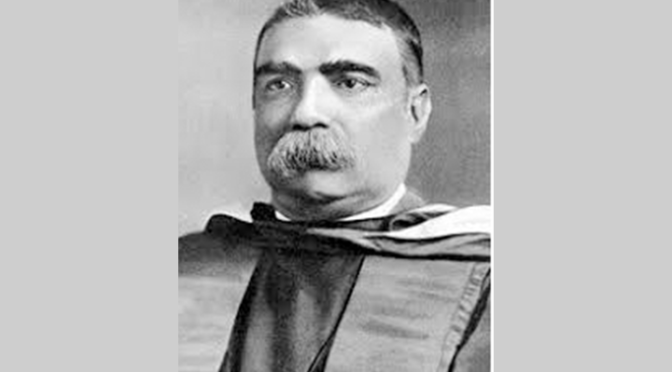Sir Ashutosh Mukherjee: A Legendary Educator
Posted on : August 26, 2018Author : AGA Admin

Popularly called in the Bengali circle as Banglar Bagh or Tiger of Bengal, the sobriquet was rightfully given to Sir Ashutosh Mukherjee for his lifelong endeavour in the field of education. He was a great jurist, a barrister and a mathematician and the first student to be awarded a dual Master’s degree in Mathematics and Physics by the University of Calcutta. At a young age, Ashutosh who was a student of Madhusudan Das, met Ishwar Chandra Vidyasagar who influenced him immensely.
At the age of fifteen; he stood second and received a scholarship in Calcutta University’s entrance exam. He took admission at Presidency College where he met Prafulla Chandra Roy and Narendranath Dutta who later, came to be popularly known as Swami Vivekananda. Later that year, though only a first-year undergraduate, he published his first mathematical paper, on a new proof of the 25th proposition of Euclid’s first book. For his achievements, Mukherjee was granted the Premchand RoyChand Fellowship in Mathematics and Physics, Pure and Applied. Mukherjee has been recognised as the first modern Indian mathematician to enter the field of mathematical research. He founded the Calcutta Mathematical Society in 1908 and continued to be its President from the beginning until his death on 25 May 1924.
At the age of 24, he became a Fellow of Calcutta University. Mukherjee was honoured by the British Crown with the title of ‘Sir’; and he also became a member of the Royal Asiatic Society of Bengal. He was elected as a Fellow of the Royal Society of Edinburgh (FRSE), Royal Astronomical Society, Physical Society of France and the Mathematical Society of Palermo, and was a member of the Royal Irish Academy, the London Mathematical Society, the Paris Mathematical Society and the American Mathematical Society. By 1888, Mukherjee was a lecturer in mathematics for the Indian Association for the Cultivation of Science (IACS).
Sir Ashutosh declined a job offer in the Department of Public Instruction in order to complete his Bachelor of Law degree from the City College, Calcutta. He won the ‘Tagore Law Gold Medal’ for three successive years: 1884, 1885 and 1886. He received his degree in 1888 and enrolled as a Vakil (Advocate) of the Calcutta High Court. By 1897, he had received an LL.D. and was appointed the Tagore Professor of Law of the Calcutta University. He had then published a book, The Law of Perpetuities in British India. Mukherjee also dabbled in politics while practicing law but gave it up when he was appointed as a puisne judge of the Bengal High Court in 1904, and subsequently served as its acting Chief Justice for a couple of years.
He was the second Indian to become the Vice Chancellor of Calcutta University, then a premier institute of learning in the country, from 1906 to 1914, and again from 1921 to 1923. The academician using his vast network of scholars and friends around the world, brought in accomplished professors; both Indian and European, to the University. Sir Ashutosh found gems like physicist C.V. Raman, philosopher Sarvepalli Radhakrishnan, mathematician Srinivasa Ramanujan, and also luminaries such as Sir P.C. Roy, widely known as the father of chemistry in modern India, and historian and epigraphist D.R. Bhandarkar, all of whom accentuated the scholarly milieu in Calcutta University. Under Sir Ashutosh, graduate courses in Comparative Literature, Applied Psychology, Industrial Chemistry, Ancient Indian History and Culture, and Islamic Culture were introduced, and also Post-graduate courses and research were started in Sanskrit and Pali in Calcutta University. He also founded the Bengal Technical Institute in 1906 and the College of Science of the Calcutta University in 1914.
There were times of intense tension during his tenure as the Vice Chancellor of Calcutta University. On one hand he was at home with the street-fighters of the freedom movement and the British Viceroy and his administrative machine on the other. On another instance, when Subhas Bose was suspended from Presidency College for assaulting Professor Oaten, for abusing Indians, Sir Ashutosh was pressurised to rusticate him. But he could not let the academic life of a brilliant student get ruined, and instead arranged for Subhas to continue his studies at the Scottish Church Missionary College.
Sir Ashutosh Mukherjee was a legend in the field of education and he contributed greatly to the rich intellectual and cultural legacy of higher education in the subcontinent. Legend has it that when Sir Ashutosh bought books at Calcutta’s famous College Street, a porter had to carry them home. He donated 80,000 books from his personal collection to the city’s National Library.
Shavi Sen
Intern
AGA





Pranam to Bengal Tiger the Legendary Educationalist – the real Tiger of Bharatmata.
very nice and intresting